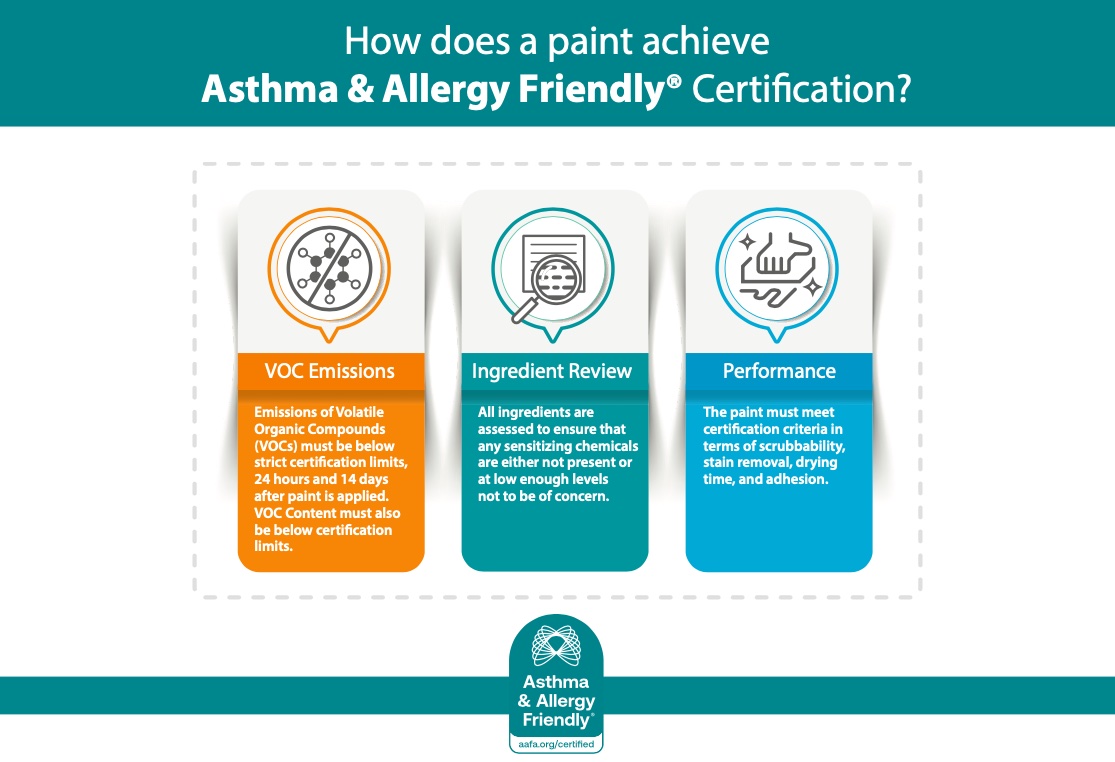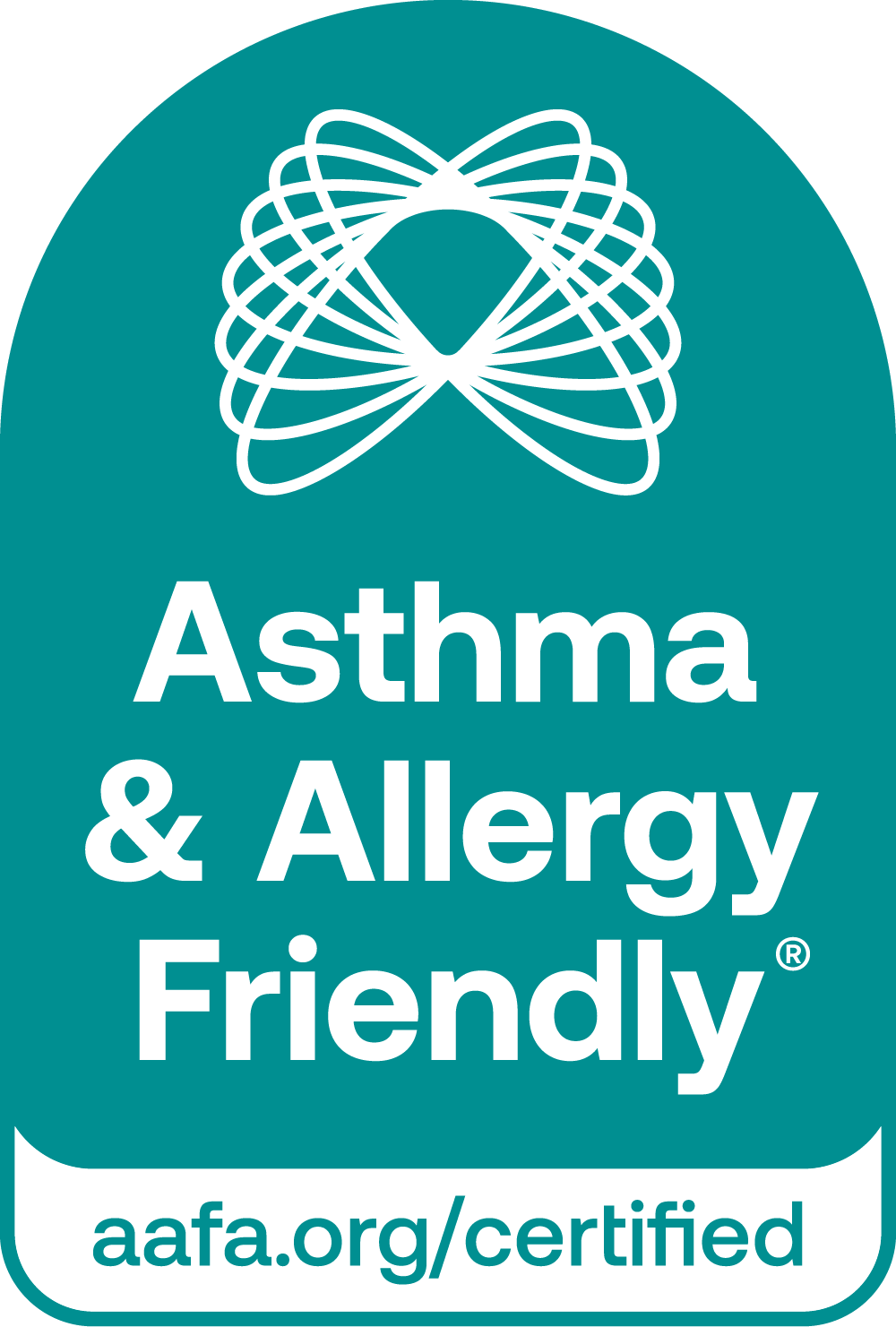How Choosing Third-Party Certified Paints Can Improve Indoor Air Quality and Support Healthier Living Environments
As we know, May is Asthma and Allergy Awareness Month, but it also marks National Building Safety Month, whose theme this year is “Game On”. This theme encourages and motivates people to get in the game and take part in learning about and practicing building safety.
With that in mind, let us teach you a little about paint: Paint can release potentially harmful chemicals into the air during and after application, which can significantly affect health, particularly for those with asthma, allergies, or chemical sensitivities.This article explores how paint impacts IAQ, the importance of third-party certification, and why Certified Asthma & Allergy Friendly® paints are an excellent choice for healthier indoor environments.
Paint and Indoor Air Quality
The primary way paint impacts indoor air quality is through the emission of chemicals, particularly volatile organic compounds (VOCs). VOCs are chemicals that evaporate into the air as paint dries. While some VOCs are relatively harmless, others can cause significant health issues, especially for those with asthma or allergies. According to the U.S. Environmental Protection Agency, exposure to VOCs can cause “eye, nose, and throat irritation; headaches, dizziness, and nausea,” and in extreme cases, long-term damage to the liver, kidneys, or central nervous system. It is advised that people with sensitivities to certain chemicals and those impacted by asthma and allergies limit exposure to VOCs as much as possible. However, considering their potential harmful effects, everyone should limit exposure to these chemicals.
VOCs are particularly concerning because they continue to off-gas even after the paint dries. This means that while the smell of fresh paint may dissipate after a few days, harmful chemicals may still linger in the air. For individuals with sensitive airways, such as those with asthma, these chemicals can exacerbate symptoms or trigger asthma attacks.
In response to growing consumer awareness, many paint manufacturers have developed low-VOC options. These paints, predominantly water-based, significantly reduce the amount of harmful emissions, making them a better choice for improving IAQ.
The Importance of Third-Party Certification
While many paint products claim to be ‘low-VOC’ or ‘non-toxic,’ not all of them meet the stringent criteria necessary to ensure safety and performance. This is where third-party certification becomes essential. Third-party certification programs, such as the Asthma & Allergy Friendly® Certification Program, test products against independent standards to confirm manufacturers’ claims. Manufacturers can voluntarily submit their paints for independent testing, and if the product meets the standards, it can be awarded certification.
For consumers, third-party certification provides peace of mind that the product they are using has been rigorously tested. Third-party certification is crucial because in some cases, full disclosure of ingredients may not be available due to proprietary formulations. This lack of transparency makes it difficult for consumers to avoid harmful chemicals on their own. A trusted certification label helps bridge that gap, guiding consumers toward wiser choices for better indoor air quality.
The Asthma & Allergy Friendly® Certification Program for Paint

The Asthma & Allergy Friendly® Certification Program takes a balanced approach when certifying paints, considering both their chemical composition and performance. It’s not possible to make paint without using chemicals, and some chemicals may have negative effects but are necessary for the product to function effectively.
The program identifies paints that do not contain unnecessarily harmful ingredients and ensures that any necessary chemicals that could cause allergic reactions are present at levels low enough to minimize concern. This thorough review makes Certified paints a better option for all consumers, particularly those with asthma or allergies.
Certified paints are subject to testing beyond standard VOC emission tests. The Asthma & Allergy Friendly® Certification Program measures VOC emissions at 24 and 14 days after application, ensuring that VOC levels remain low from the outset. Though the majority of VOC off-gassing typically happens during the first week after painting, surfaces can continue to emit VOCs at varying levels, which may be of concern particularly for sensitive individuals. Many standard certifications only test after a 10-day conditioning period, which may not reflect real-world usage, where immediate air quality is a concern for consumers painting their own homes. Furthermore, in settings such as healthcare and commercial spaces, frequent repainting is often necessary, making odor and return-to-service time key factors. Low VOC levels at 24 hours means less downtime for hospitals, schools, and businesses, supporting a healthier indoor environment without prolonged closures.
The Broader Impact of Paint Certification
The Asthma & Allergy Friendly® Certification Program works with major paint manufacturers to certify their products. These companies recognize the importance of reducing their environmental footprint while also improving IAQ for their consumers. By achieving certification, they demonstrate a commitment to corporate responsibility and consumer well-being. With their focus on the planet, sustainability, and people, they are paving the way for all paint manufacturers.
As more consumers become aware of the negative environmental and health impacts of conventional paints, the demand for superior products grows. Certified paints play a vital role in the healthier buildings movement. Studies show that indoor air can be two to five times more polluted than outdoor air, and with people spending up to 90% of their time indoors, it is clear that we need to reduce exposure to potentially harmful chemicals. Certified paints contribute to creating healthier homes, schools, and workplaces.
Notably, Certified Asthma & Allergy Friendly® paints align with the US. Green Building Council’s (USGBC) LEED program and are eligible for credits for low-emitting materials. Additionally, these Certified products are compliant with WELL Feature X06 Part 1b4 of the WELL Building Standard. This helps companies meet sustainability goals while improving IAQ.
Introducing Our Certified Partners: Benjamin Moore, True Value, and Master Paints
We are proud to partner with Benjamin Moore, True Value, and Master Paints, all of whom are committed to improving indoor air quality through their Certified paints.
- Benjamin Moore: Known for its long history of innovation in paint technology ( this year Benjamin Moore celebrates 10 years Certified Asthma & Allergy Friendly®) Benjamin Moore’s Eco Spec® is designed for spaces where indoor air quality is a top priority. This paint meets the stringent standards of the Asthma & Allergy Friendly® Certification Program for low VOC emissions. Benjamin Moore’s commitment to innovation and sustainability continues to drive advancements in paint technology, providing science-backed solutions for healthier indoor spaces. According to Edja Kouassi, Senior Marketing Manager at Benjamin Moore,
“Eco Spec® is a product that meets the Asthma & Allergy Friendly® certification criteria for low VOC emissions, which confirms the attributes we talk about with this product. Having a third party like the certification program confirm this is very important for us.”
- True Value: Since 2018, True Value has worked closely with the Asthma & Allergy Friendly® Certification Program to ensure its EasyCare® paint brand contributes to healthier indoor environments. The certification process has helped True Value rebuild consumer trust, particularly after a previous “dead last” ranking by Consumer Reports in 2014. By achieving certification, True Value has improved sales and consumer confidence. True Value’s commitment to healthier homes extends beyond business, with initiatives like Painting a Brighter Future, which has donated over 68,000 gallons of paint to schools and nonprofits. In 2024, True Value received the Asthma & Allergy Friendly® Certification Program’s inaugural ESG and Community Award, recognizing their dedication to improving indoor environments and supporting health awareness.
- Master Paints: Master Paints demonstrated its commitment to consumer well-being in 2024 by achieving the Asthma & Allergy Friendly® Certification for its Eco Pure paint range. Ricardo Cardona, President of Master Paints, said,
“At Master Paints, our dedication lies in creating high-performance products that not only exceed the highest standards but also promote environmental enhancement and an enriched quality of life.”
For over 23 years, Master Paints, a Puerto Rican company, has been developing an extensive selection of high-performance architectural paints, roof sealers, among others. Their products are distributed from Puerto Rico to the Caribbean Islands, Panama, and Colombia. Beyond just its goods, Master Paints also funds programs and projects that validate their corporate commitment to social and environmental responsibilities.
Conclusion
Paint may seem like a simple home improvement product, but its impact on indoor air quality is significant. VOC emissions from conventional paints can lead to a range of health issues, particularly for individuals with asthma or allergies. Fortunately, advancements in paint technology and the availability of third-party certification programs make it easier than ever to choose better options.
The Asthma & Allergy Friendly® Certification Program helps consumers identify paints that are independently tested for low emissions and high performance. Indoor air quality is of particular concern for those affected by asthma and allergies, but a healthier home is beneficial for everyone.
